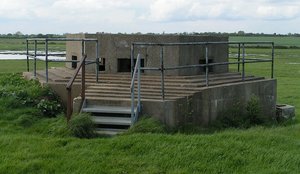Blockhouse
|
|
In military science, a blockhouse is a small, isolated fort in the form of a single building. Originally blockhouses were constructed as part of a large plan, to "block" access to vital points in the scheme. But from the Age of Exploration to the nineteenth century standard patterns of blockhouses were constructed for defence in frontier areas, particularly South Africa, New Zealand, Canada, and the United States.
Blockhouses may be made of masonry where available, but were commonly made from very heavy timbers, sometimes even logs arranged in the manner of a log cabin. They were usually two or even three storeys, with all storeys being provided with embrasures or loopholes, and the uppermost storey would be roofed. If the structure was of timber, usually the upper storey would project outward from the lower so the upper storey defenders could fire on enemy attacking the lower storey, or perhaps pour water on any fires. When the structure had only one storey, its loopholes were often placed close to the ceiling, with a bench lining the walls inside for defenders to stand on, so that attackers could not easily reach the loopholes.
Blockhouses were normally entered via a sturdy, barred door at ground level. Most blockhouses were roughly square in plan, but some of the more elaborate ones were hexagonal or octagonal, to provide better all-around fire. In some cases, blockhouses became the basis for complete forts, by building a palisade with the blockhouse at one corner, and possibly a second tower at the opposite corner. Many historical stone blockhouses have survived, and a few timber ones have been restored at historical sites. In New Zealand, a number of one storey timber blockhouses survive from the Maori Wars, while stone blockhouses from the Boer War are relatively common in South Africa.
Concrete blockhouses
During the First and Second world wars many types of blockhouses were built, when time allowed they were usually constructed of reinforced concrete. The major difference between a blockhouses and a bunker is that a bunker is constructed mostly below ground level while a blockhouse is constructed mostly above ground level.
Some blockhouses like those constructed in England in 1940 were built for traditional fortification reasons, they were often hexagonal in shape and were called pillboxes. Between 20 and 30 thousand were built in Britain during the WWII.
In London the Admiralty Citadel is one of the most sturdy above ground structures built during World War II. It was constructed in 1940-1941 as a bomb-proof operations centre for the Admiralty, with foundations nine metres deep and a concrete roof six metres thick.
Hochbunker_Leitturm_Augarten.jpg
In Berlin and other cities during the World War II some massive blockhouses were built as air-raid shelters and Anti-aircraft artillery platforms. They were called Hochbunker "High Bunkers". Some were over 6 stories high. Several survive to this day because the cost of demolition would be prohibitive. The Pallasstrasse air-raid shelter, Schöneberg has a post-war block of flats built over the shelter. During the Cold War the shelter was in use as a NATO food-store.[1] (http://www.geocities.com/lupinpooter/berlin2a.jpg)
External links
- Berlin Air-raid Shelters, Flak Towers and Bunkers (http://www.geocities.com/lupinpooter/berlin.htm)
- http://www.heritage.me.uk/misc/pillboxes.htm
- Information on Australian World War 2 Fortifications (http://www.tunnelrats.org.au)de:Blockhaus (Militär)

